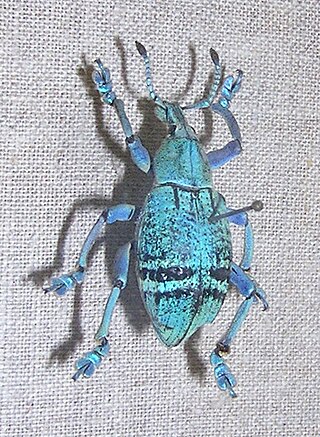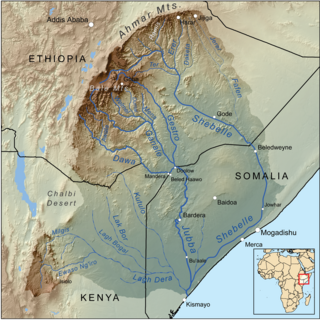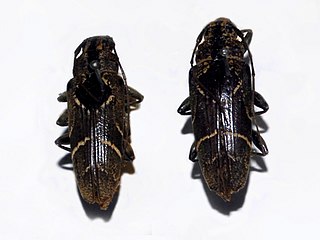
Pisum is a genus of flowering plants in the family Fabaceae, native to southwest Asia and northeast Africa. It contains one to five species, depending on taxonomic interpretation; the International Legume Database (ILDIS) accepts three species, one with two subspecies:

Somalia is officially divided into 18 administrative regions. These are in turn subdivided into seventy-two districts

Calosoma sycophanta, the forest caterpillar hunter, is a species of ground beetle belonging to the family Carabidae.

Eupholus is a genus of beetle in the family Curculionidae. The genus includes some of the most colourful of the weevils. The colour may serve as a warning to predators that they are distasteful. Most species feed upon yam leaves, some of which are toxic to other animals. The species occur in New Guinea and adjacent islands. This genus was described by French entomologist Jean-Baptiste Alphonse Dechauffour de Boisduval in 1835.

Calosoma is a genus of large ground beetles that occur primarily throughout the Northern Hemisphere, and are referred to as caterpillar hunters or caterpillar searchers. Many of the 167 species are largely or entirely black, but some have bright metallic coloration. They produce a foul-smelling spray from glands near the tip of the abdomen. They are recognizable due to their large thorax, which is almost the size of their abdomen and much wider than their head.

Weyib River is a river of eastern Ethiopia. It rises in the Bale Mountains east of Goba in the Oromia Region, flowing east to pass through the Sof Omar Caves, then to the southeast until it joins the Ganale Dorya River in the Somali Region.

Calosoma inquisitor is a species of ground beetle. The species is found in northern Africa, Europe and East to Asia Minor, Iran and the Caucasus, with isolated populations in eastern Siberia and Japan.
Jasminium abyssinicum is a species of jasmine, in the family Oleaceae.

Calosoma investigator is a species of ground beetle belonging to the genus Calosoma and the subgenus Charmosta. The species is diffused in North-Eastern Europe and Siberia.

Calosoma elegans is a species of ground beetle in the family Carabidae. It is found in Kazakhstan, Kyrgyzstan, and China.

Carabinae is a subfamily of ground beetles in the family Carabidae. There are about 10 genera and more than 1,400 described species in Carabinae.
Calosoma antinorii is a species of ground beetle in the subfamily of Carabinae. It was described by Gestro in 1878.
Calosoma discors is a species of ground beetle in the subfamily Carabinae. It was described by John Lawrence LeConte in 1857.
Calosoma himalayanum is a species of ground beetle in the subfamily of Carabinae. It was described by Gestro in 1875.

Tmesisternus is a genus of longhorn beetles belonging to the family Cerambycidae, subfamily Lamiinae.

Trigonoptera is a genus of longhorn beetles of the subfamily Lamiinae, containing the following species:

Callispa is a genus of tortoise beetles.

Pseudocolaspis is a genus of leaf beetles in the subfamily Eumolpinae. It contains about 80 species, which are found in tropical Africa.

Afrosciadium abyssinicum, synonym Peucedanum abyssinicum, is a member of the carrot family, Apiaceae. It is native to Ethiopia, where it grows at high elevations.














